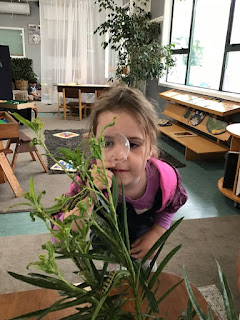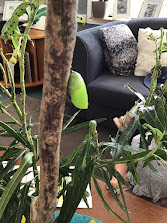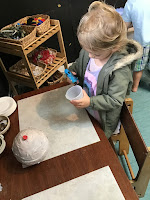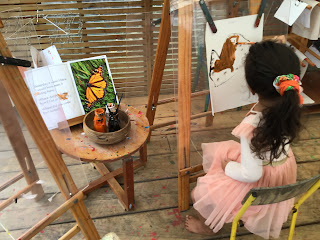Tamariki began observing the caterpillars, drawing what they saw, asking questions, and investigating using the insect books provided. Tamariki explored the changes occurring within this area throughout the days, both alongside their e hoa and on their own.
Some of our caterpillars
were named by the tamariki.
“Slinky,
plinky, blinky, twinky and blonky.”
On the Monday of the following week we discovered that five caterpillars had turned into chrysalises. This provoked more observations, questions, and research.
During this period together we shared some in depth discussions about the way the remaining caterpillars moved on the plant, the transition of caterpillars to a chrysalis, how different they looked, and the colours and shapes we could see were slowly emerging on the chrysalis.
Tamariki used
pens and paper and began drawing what they could see, their very own
caterpillar and chrysalis. I was so impressed by their observational drawing
and the detail to their artwork. For many tamariki art is an area of interest
as it allows them to be creative. Many tamariki continued to revisit this
area, creating many more pieces of artwork. Observational drawing is an
excellent way to help tamariki learn to draw what they see. In accordance with
Kolbe (2009), it invites tamariki to look very closely at things and to notice
all the details. In turn it encourages tamariki to make more intricate drawings
than they do from memory alone, often leading to joyful discoveries. It is part
of the process of ‘learning to see’. When students draw pictures of things they
see, it enhances their observation of these things (Haydock).
Observational drawing can support tamariki to strengthen memory. As the tamaiti looks at the object and remembers what they see in order to create their own image, they develop fine motor skills, spatial awareness, concentration and focus, observational skills and visual communication skills. This process also assists tamariki to reinterpret a three- dimensional form into a two-dimensional form, engaging with concepts such as depth and scale. In doing this, tamariki develop understanding of the outline, structure and form of objects. Through drawing tamariki communicate what they see, what they imagine, and what they want to communicate, often focusing on different aspects and details of the object they observe.
Different resources and experiences were set up around our environment, encouraging tamariki to explore this interests through a range of media. Our book of the week during this time was The Very Hungry Caterpillar by Eric Carle. Tamariki linked their observations to the process by which a caterpillar morphs into a butterfly, beginning with a very hungry caterpillar hatching from an egg.
The next week, we began exploring many other art techniques. We created chrysalis using the paper mâché technique of tearing up paper and gluing it onto a balloon. There were further discussions shared throughout the progress of these sculptures. We had to problem solve how to transform these materials into a chrysalis shape, then a few days later once the first layer was dry, we added some loose parts to one end before repeating the next layer of paper mâché. Tamariki began discussing what colours our chrysalis should be. Some suggested green and some suggested black referring to their recent observations. Once dried we decided on the colour green, and these were painted.
Tamariki also
began creating caterpillars in our hot glue gun area using a range of resources including sticks, egg cartoons, ice block sticks and paint. This led into clay
work, as they created eggs and more caterpillars. “Clay work can be a language for
exploring and communicating ideas. Like drawing, clay work enables children to
make their ideas visible – but in three dimensions” (Koble, 2009). All the
amazing artwork created over this time was then displayed in the kindergarten
for tamariki and their whānau to see.
Many days later, on our way out to enjoy morning tea a group of tamariki and myself noticed a change in one of the chrysalises. When we went closer, we were just in time to witness our first monarch butterfly emerge from its chrysalis, what a special moment this was.
This process
is called metamorphosis. This is a Greek word that means transformation or
change in shape. https://ansp.org/exhibits/online-exhibits/butterflies/lifecycle/
"Under a leaf in a hidden place, can you see an empty case?"
(Flutterby butterfly, Anne
Cochrane).
Through our
observations we noticed that its wings were small and crumpled, and its abdomen
was plump. As the newly emerged butterfly hung upside down, we also noticed
fluid expelling. After some more research, we found out this was called
meconium. This is metabolic waste built up while inside
the chrysalis and its expulsion is a normal occurrence to
successfully complete metamorphosis.
https://monarchbutterflylifecycle.com/blogs/raise/hatching-butterflies-monarch-emerges-chrysalis
We continued
to observe our newly emerged butterfly as its wings expanded and dried. During
this time, we reminded our tamariki that we needed to be respectful of the
butterfly and that when it was ready, it would fly away on its own.
Tamariki voice:
“Caterpillars
eat leaves and stalks.”
“The poo is
blackish greenish.”
“I seen
caterpillars at my house, can’t touch caterpillars otherwise they die” – Micaela.
“First time I saw
a new butterfly flying around at the hotel”- Kehlani.
“They are so special,
and you can’t touch them otherwise they will die” – Indie.
“Don’t touch
them” – Lucas.
“Butterflies won’t
hurt us” – Dawn.
“The butterfly
came out” – Lexie.
“I saw a lot of
chrysalises” – Millen.
“I like
watching them and grow getting out of their egg, the chrysalis they have to
break, that’s how they turn into butterflies, they have bumps on them when they
start to get bigger, they grow and grow” – Lucas.
“Our
butterflies are all gone, they all turn into chrysalis then they turn into
butterflies” – Aki.
This long-term
project provided many opportunities for tamariki to participate.
It provided opportunities for tamariki to revisit their ideas, lead their own learning, work alongside others, share ideas, investigate, gain knowledge and skills, ask questions and make sense of the information they were learning.
Projects provide a flexible and sustainable platform for tamariki to explore and discover and to develop their critical thinking and problem-solving abilities. Projects allow curious young minds to explore and discover, they allow young children’s ideas to be valued, their creativity encouraged, their interests nurtured and their learning needs met. Importantly, because projects are open-ended and there is no right or wrong answer in project development, a child can fully explore their creative thought processes without fear of failure.
‘What children learn does not follow as an automatic result from what is taught, rather, it is in large part to the children’s own doing, as a consequence of their activities and our resources.’
https://nido.edu.au/news/project-based-learning-in-early-learning-centres/
Written by Emma
Q






































































































